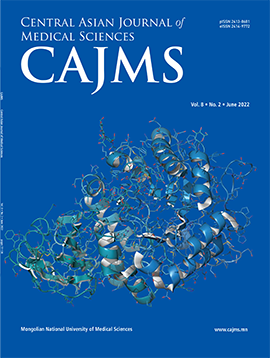Rehabilitation Treatment Outcomes among Stroke Patients with Dysphagia
DOI:
https://doi.org/10.24079/cajms.2021.09.012Keywords:
Nerve Stimulation, Muscular Stimulation, VideofluoroscopyAbstract
Objectives: Dysphagia is a major complaint following stroke and occurs 37-78% of the time. It is associated with poor clinical outcome and high mortality rates. There are approximately 220-290 new stroke cases per 100.000 person-years in Mongolia and 178-260 in China. Rapidly changing lifestyles, socioeconomic status, stress, and increasing cardiovascular diseases are leading causes of stroke in the world and its diagnosis and treatment are one of the challenges of health care. Therefore, we aimed to characterize the swallow status and treatment outcome among dysphagic patients. Methods: The study was conducted in a hospital-based, cross-sectional method. Study participants were obtained from the Affiliated Hospital of Inner Mongolian University for the Nationalities between July 2018 and March 2019. All patients were randomly divided into three treatment groups. 149 patients with dysphagia were evaluated by video fluoroscopic assessment (VFSS) before and after the treatment. Results: In total, 149 participants (mean age = 59.70 ± 9.55 years) aged between 34-77 were obtained in this study. There were no statistically significant differences between the three groups in age (p = 0.583). The data showed a statistically significant positive treatment effect for all three groups (p = 0.000). The VFSS score was 7.94 ± 1.04 in the A group, 7.52 ± 1.12 in the B group, and 8.36 ± 0.98 in the C group after the treatment. The VFSS score shows a statistically significant difference, after the treatment (p = 0.000). Conclusion: Rehabilitation treatment combined with neuromuscular electrical simulation shows a better outcome than rehabilitation treatment without combined neuromuscular stimulation among stroke patients with dysphagia. The assessment of swallowing function should include both clinical and video fluoroscopic evaluation. Video fluoroscopic features are important predictors of swallowing abnormalities and complications.
Downloads
548
Downloads
Published
How to Cite
Issue
Section
License
Copyright (c) 2021 Mongolian National University of Medical Sciences

This work is licensed under a Creative Commons Attribution-NonCommercial 4.0 International License.




